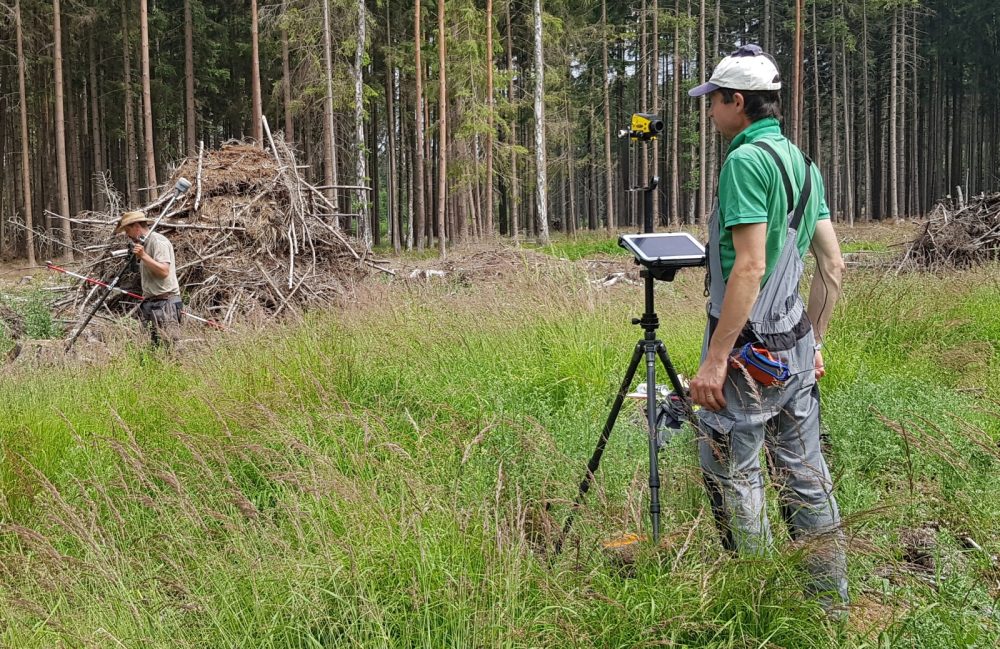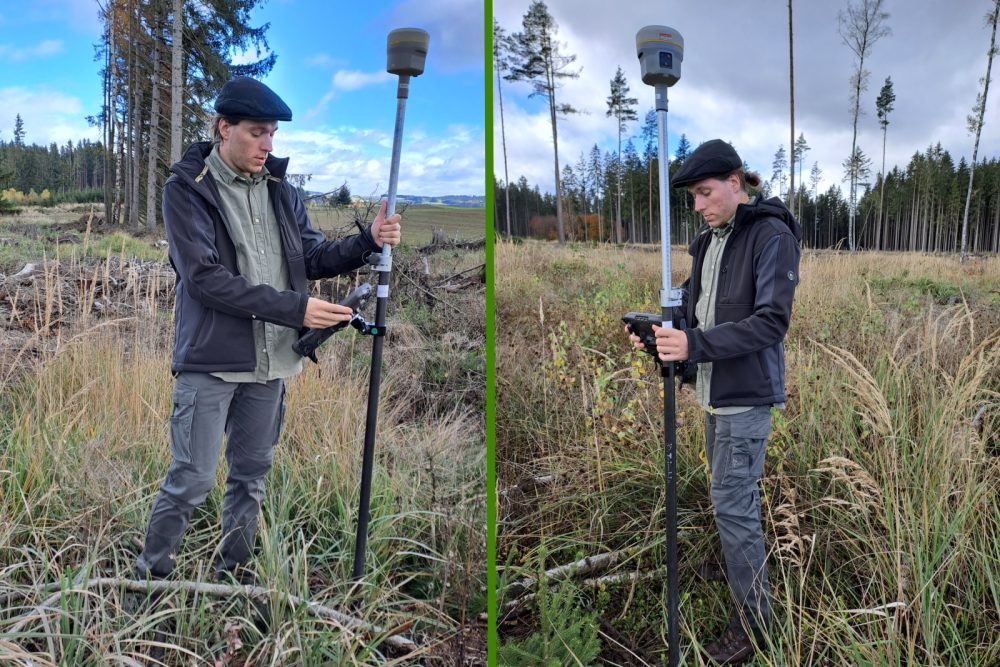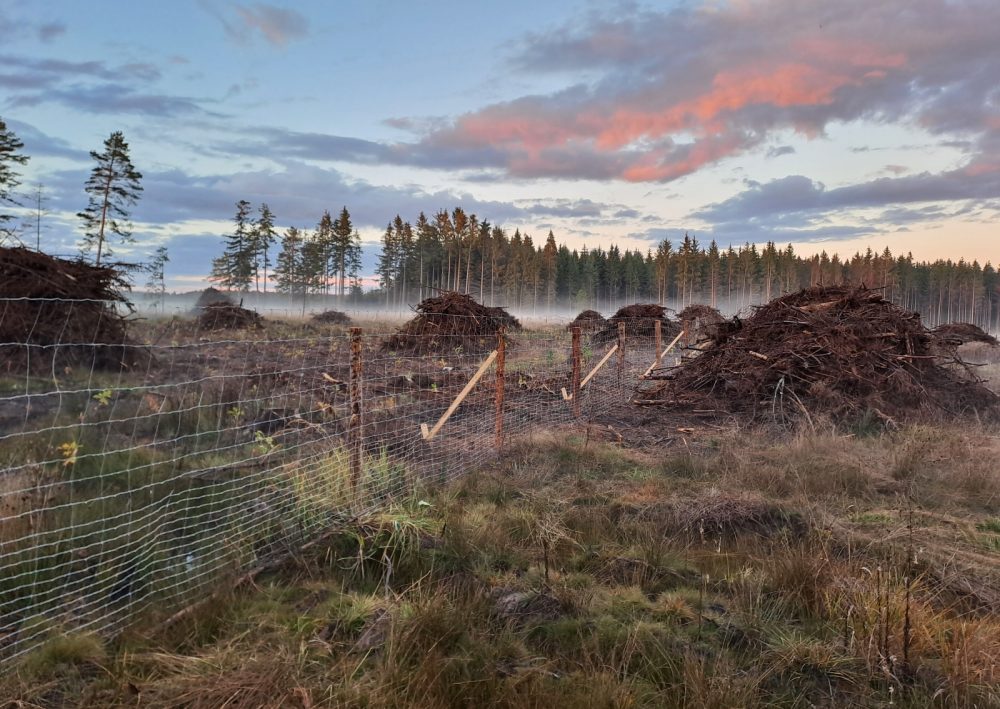LDO Přibyslav is an example of good practice for owners of forests affected by bark beetle calamity
The regeneration of forest stands on large-scale clearings that arose as a result of the bark beetle calamity is currently a challenging task for many forest owners. In addition to the issue of substantial financial investments, it is necessary to secure working capacities, which are critically lacking in forestry. At the same time, many, especially small owners, do not have enough information and expertise and are solving the question “How to do it? “
 Photo: Determining the size of clearings using Field Map technology, author Monika Vejpustková
Photo: Determining the size of clearings using Field Map technology, author Monika Vejpustková
The project “Implementation of innovative forest restoration procedures in calamity clearings with regard to the support of biodiversity and increasing the functionality of forest ecosystems” can help answer this question. This project is being carried out by the Forestry and Game Management Research Institute, with the support of Norwegian funds and the State Environmental Fund of the Czech Republic, in cooperation with the Přibyslav Municipal Forest Cooperative (LDO).
The project is aimed to implementation of an exemplary method of forest restoration after the bark beetle calamity with an emphasis on the species, age and spatial diversity of the regenerated stands in order to increase the biodiversity and resilience of the forest stands. The result of the project’s implementation will serve as an example of good practice for the owners of forests affected by the bark beetle not only from the given region, but also from other affected areas of the Czech Republic.
The project started in April 2022, when, based on consultations with the foresters of LDO Přibyslav, suitable locations in the Nové Veselí and Račín forests were selected and mapped in detail. Selected locations were localized in detail by FieldMap and Trimble R12i technology.
 Photo: Determining the size of clearings by Trimble R12i technology, author Tomáš Čihák
Photo: Determining the size of clearings by Trimble R12i technology, author Tomáš Čihák
Particular attention has been paid to the occurrence of natural rejuvenation, the site conditions and the current management of clearings in terms of the state of disturbance and the processing of logging residues. Also, the occurrence of other additional elements, such as the road network or the routes of existing melioration ditches, was mapped, too.
The mentioned mapping was followed up by evaluating the initial parameters of biodiversity within tree species layer and ground vegetation, together with selection of groups of invertebrates and birds, with special attention to protected and endangered species.
At the same time, scientists implemented the first stage of selecting suitable habitat trees. These are mostly old trees that provide valuable refuge for birds and insects. Geographical coordinates, dendrometric characteristics and a description of habitat features, including photo documentation, are available for each registered tree. In the autumn 2022, phytopathological survey at the locations of interest, has been also conducted.
 Photo: Afforestation at the Nové Veselí locality, author Tomáš Čihák
Photo: Afforestation at the Nové Veselí locality, author Tomáš Čihák
Based on the results of the field investigations, introductory project for the first stage of restoration of the affected areas has been developed for the first stage of restoration of the affected areas. This project was implemented in the autumn 2022. As a result, all the organic matter of the logging residues remains in the vegetation and there is no loss of nutrients from the ecosystem.
A wide variety of domestic tree species has been used during the afforestation. In the future, the visitor to the forest will find both common deciduous species, such as oak or beech, as well as less common trees, such as wild cherry, in the restored forest. During the preparation of the afforestation project, increased attention was paid to species with ameliorating and strengthening effects.
In particular, deciduous trees such as wild cherry, sycamore maple, linden or alder have a positive effect on site quality, which is long-term influenced by the conifers’ silviculture, especially Norway spruce. The pioneer species of silver birch and European aspen have also been applied in the afforestation of large-scale clearings.
Norway spruce, Scots pine and silver fir were also planted to a limited extent in suitable sites. The protection of cultures against browsing was implemented by building fences, using protective plastic tubes and by coating the seedlings, in some cases.
 Photo: Newly built game-proof fence and harvested brushwood on the Nové Veselí locality, author Tomáš Čihák
Photo: Newly built game-proof fence and harvested brushwood on the Nové Veselí locality, author Tomáš Čihák
When establishing new forest stands, forest scientists paid increased attention to measures to support biodiversity. This includes the use of natural regeneration, establishment of mixed stands, care for site suitable trees, leaving logging residues or whole stems, and a total effort to achieve the greatest possible spatial and species differentiation of newly established stands.
As part of the project solution, advanced restoration elements were also implemented in the fragments of the surrounding spruce stands. These objects (gaps) will form the structure of new stands, being created on the place of existing spruce stands.
The second stage of forest regeneration is planned for 2023. The implementation of this stage will take place on the areas destined as part of the mapping in the autumn 2022 and will be based on the same principles as the previous stage. The goal of our efforts remains the same. This is the establishment of a species- and spatially differentiated forest, which is ready to withstand the effects of climate change and at the same time it supports biodiversity and the fulfilment of non-production functions to the maximum extent.
Contact: Ing. Tomáš Čihák, Ph.D., Ing. Monika Vejpustková, Ph.D., VULHM, v. v. i. (FGMRI), Dept. of Forest Ecology, e-mail: cihak@vulhm.cz, vejpustkova@vulhm.cz
